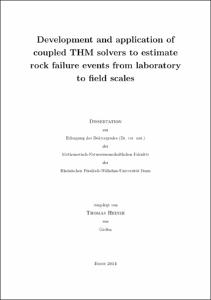Heinze, Thomas: Development and application of coupled THM solvers to estimate rock failure events from laboratory to field scales. - Bonn, 2015. - Dissertation, Rheinische Friedrich-Wilhelms-Universität Bonn.
Online-Ausgabe in bonndoc: https://nbn-resolving.org/urn:nbn:de:hbz:5n-40500
Online-Ausgabe in bonndoc: https://nbn-resolving.org/urn:nbn:de:hbz:5n-40500
@phdthesis{handle:20.500.11811/6492,
urn: https://nbn-resolving.org/urn:nbn:de:hbz:5n-40500,
author = {{Thomas Heinze}},
title = {Development and application of coupled THM solvers to estimate rock failure events from laboratory to field scales},
school = {Rheinische Friedrich-Wilhelms-Universität Bonn},
year = 2015,
month = jul,
note = {In this thesis I present a theoretical and numerical model to simulate complex fluid-rock interactions with a poro- elasto- plastic rheology, multi- phase flow and heat transport (THM- model). Goal of this work is to improve existing approaches fundamentally by elaborating a better, dynamic rheological model as well as developing tools to improve the comparison between simulation and observations on field and laboratory scale.
This work contains the derivation and implementation of a two- surface plastic damage model, a method to detect a numerical analog for acoustic emissions in rock samples and a simulation of earthquake swarms in western bohemia. The developed damage model outnumbers existing approaches in terms of a realistic reproduction of experimental measurements and will be usefull for future simulations of drained and undrained rock deformations. Especially if the rock is subjected to cyclic load or pore pressure, damage effects are essential. In fluid- rock systems this can often be the case due to temporarily increasing and decreasing fluid pressure. Reoccurring, fluid- driven earthquake swarms and stimulation of geothermal fields with hydrofracturing are examples for this. Acoustic emissions (AE) and (micro-) seismic events contain important information on a very local range which can not be resolved by other measurement techniques. On the other hand, there is no physical property directly related to AE. In this work I present a straightforward mechanism to obtain a proxy for acoustic emissions during a numerical simulation which agrees very well with laboratory measurements. The same mechanism can be extended to field scale for detecting and localizing earthquakes. I present an application of this method to the 2008 earthquake swarm in West- Bohemia (Czech Republic). Using the developed method I am abel reproduce the localization, temporal evolution and magnitude distribution of the original earthquake catalog.
The projects examined in this thesis are suitable over a wide range of use cases. Industrial applications like geothermal energy or CO2 sequestration can profit from presented methods and natural phenomena like earthquake swarms can be examined in more detail. Several aspects of this work are not even limited to geoscience and can be helpful in other subjects like material science and civil engineering. To validate and enable a reasonable usage of the theoretical model a numerical implementation is presented for all developed models.},
url = {https://hdl.handle.net/20.500.11811/6492}
}
urn: https://nbn-resolving.org/urn:nbn:de:hbz:5n-40500,
author = {{Thomas Heinze}},
title = {Development and application of coupled THM solvers to estimate rock failure events from laboratory to field scales},
school = {Rheinische Friedrich-Wilhelms-Universität Bonn},
year = 2015,
month = jul,
note = {In this thesis I present a theoretical and numerical model to simulate complex fluid-rock interactions with a poro- elasto- plastic rheology, multi- phase flow and heat transport (THM- model). Goal of this work is to improve existing approaches fundamentally by elaborating a better, dynamic rheological model as well as developing tools to improve the comparison between simulation and observations on field and laboratory scale.
This work contains the derivation and implementation of a two- surface plastic damage model, a method to detect a numerical analog for acoustic emissions in rock samples and a simulation of earthquake swarms in western bohemia. The developed damage model outnumbers existing approaches in terms of a realistic reproduction of experimental measurements and will be usefull for future simulations of drained and undrained rock deformations. Especially if the rock is subjected to cyclic load or pore pressure, damage effects are essential. In fluid- rock systems this can often be the case due to temporarily increasing and decreasing fluid pressure. Reoccurring, fluid- driven earthquake swarms and stimulation of geothermal fields with hydrofracturing are examples for this. Acoustic emissions (AE) and (micro-) seismic events contain important information on a very local range which can not be resolved by other measurement techniques. On the other hand, there is no physical property directly related to AE. In this work I present a straightforward mechanism to obtain a proxy for acoustic emissions during a numerical simulation which agrees very well with laboratory measurements. The same mechanism can be extended to field scale for detecting and localizing earthquakes. I present an application of this method to the 2008 earthquake swarm in West- Bohemia (Czech Republic). Using the developed method I am abel reproduce the localization, temporal evolution and magnitude distribution of the original earthquake catalog.
The projects examined in this thesis are suitable over a wide range of use cases. Industrial applications like geothermal energy or CO2 sequestration can profit from presented methods and natural phenomena like earthquake swarms can be examined in more detail. Several aspects of this work are not even limited to geoscience and can be helpful in other subjects like material science and civil engineering. To validate and enable a reasonable usage of the theoretical model a numerical implementation is presented for all developed models.},
url = {https://hdl.handle.net/20.500.11811/6492}
}






